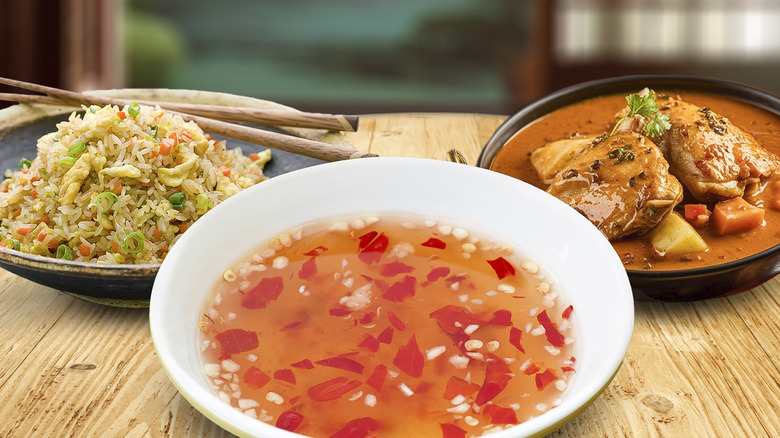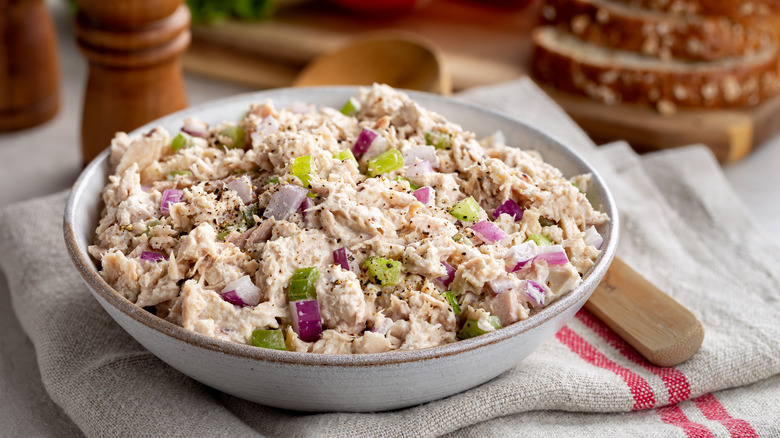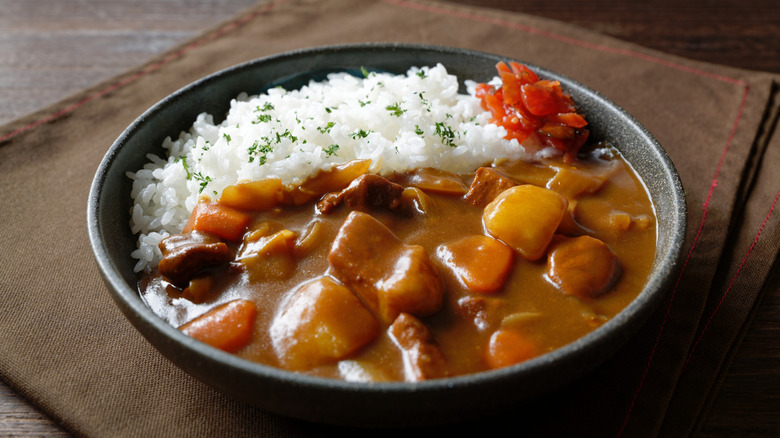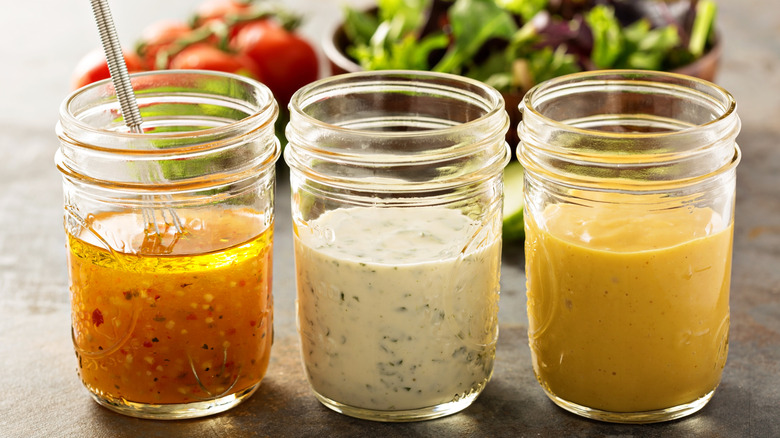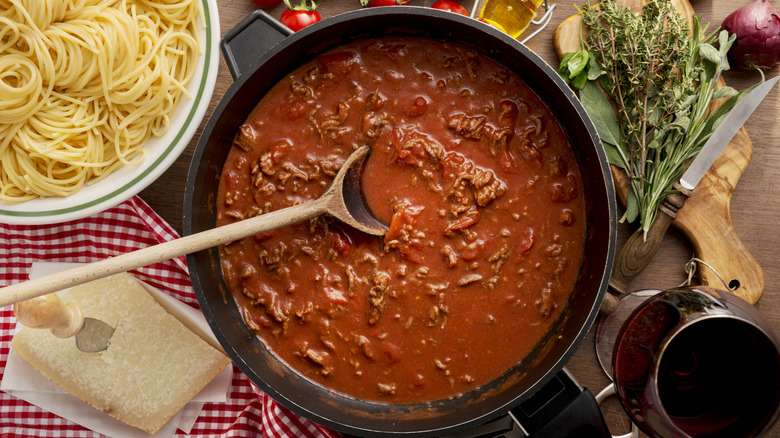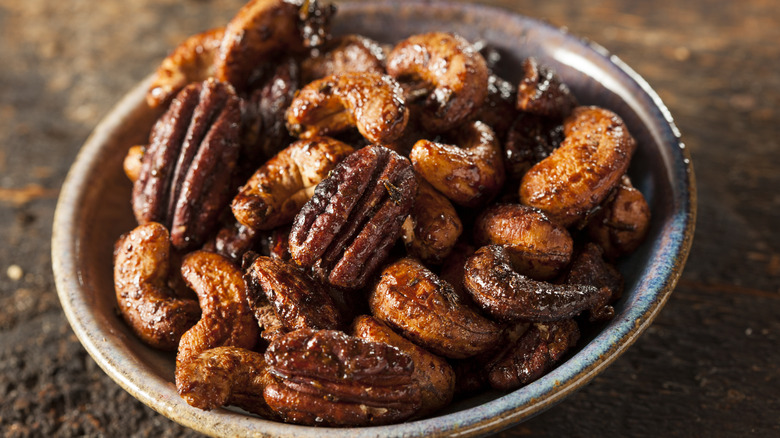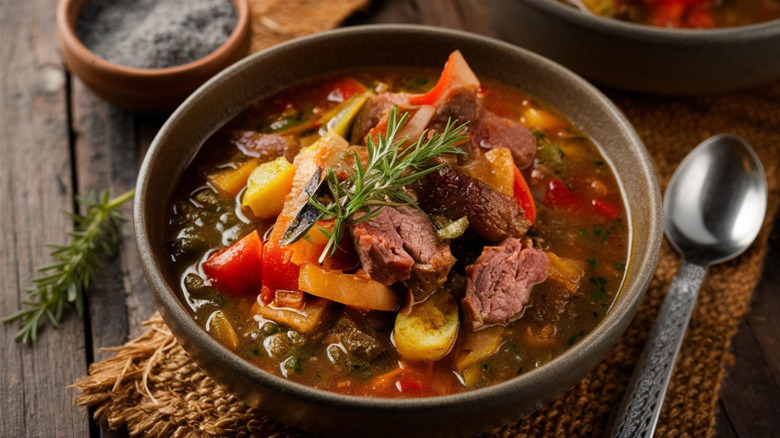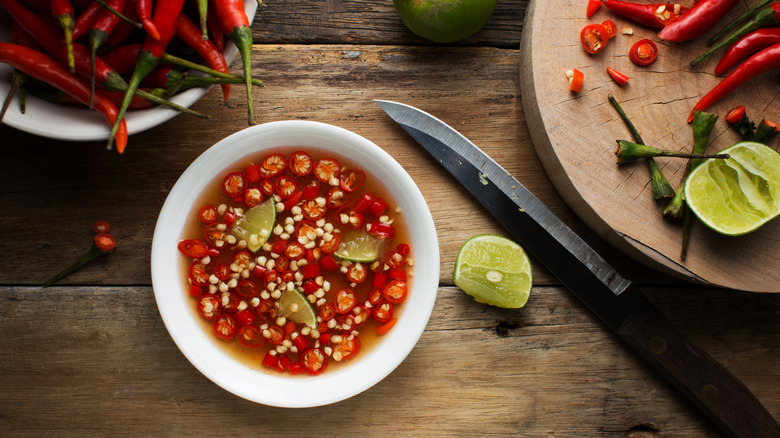15 Delicious Ways To Use Fish Sauce
Fish sauce might just be the secret ingredient your kitchen has been missing. This umami-rich condiment is a staple in Southeast Asian cuisine, but it can be used to flavor all kinds of dishes. It's made by fermenting fish with salt. The fermentation process breaks down the fish and draws out liquid, which is strained and sometimes matured. The result is an aromatic sauce that is salty, savory, and just a touch tangy and sweet.
There are several styles of fish sauce to choose from. Thai fish sauce is typically deep brown and very pungent. South Korean fish sauce can be slightly malty, while Vietnamese fish sauce is often light in color and has a subtle flavor. Regardless of the type you choose, a little bit of fish sauce goes a long way. Just a splash can add depth to dishes, enhance savory notes, and balance other flavors.
The sky's the limit when it comes to cooking with fish sauce. You can use it to deepen the richness of soups and stews, boost the vibrancy of salads, and upgrade roasted and baked dishes. It can also be used to create complex sauces. If you've ever wondered how to get more out of your fish sauce, these 15 delicious ideas will show you just how versatile it can be.
1. Create an umami-bomb sauce for roasted vegetables
Roasted vegetables make for a great side dish, but they can be bland if they're not seasoned well. Fish sauce is a great addition because the umami element can bring out the earthy flavors of mild vegetables like potatoes and cauliflower. It can also temper sweetness in vegetables that are high in sugar like carrots and beets. Upgrade your Brussels sprouts with fish sauce and you may find the sprouts taste nuttier. Roasted broccoli can also benefit from a briny hit of fish sauce.
To give your roasted vegetables an umami upgrade, toss them with a few teaspoons of fish sauce and oil before roasting. As the vegetables roast, the fish flavor will soften and meld with the other flavors. You can also make a tangy vinaigrette with fish sauce and rice wine vinegar to toss on after the veggies have been roasted. If you want something a bit more intense, consider making a sweet and savory fish sauce caramel. Just simmer your fish sauce with some water and palm sugar or brown sugar, then drizzle the thickened sauce over your veggies.
2. Amp up the flavor of your your tuna salad
It's hard to imagine a more classic lunch dish than tuna salad. Part of its appeal is that you don't need much to create it. Just mix some canned tuna with mayo and some crunchy elements and you're good to go. However, if you really want to amp up the flavor, consider adding fish sauce. It adds a savory touch that works beautifully with the meatiness of the fish and the richness of the mayo. Add something acidic like vinegar or chopped pickles, and you have a great balance of flavors.
The trick to using fish sauce in tuna salad is to start small. About a ½ teaspoon per can of tuna should be enough to add some umami flavor without making the salad too fishy tasting or soggy. Also, keep in mind that the fish sauce is slightly salty, so you may want to go easy on any extra salt. Be sure to mix everything well to ensure the fish sauce adds flavor to every bite.
3. Concoct a complex curry sauce
Fish sauce often makes an appearance in Thai curries as a savory flavor booster. Thai dishes typically include a range of flavors such as spicy, sour, sweet, and salty. In Thai curries you usually have spicy curry paste made with chiles, sweetness from palm sugar or brown sugar, sour notes from lime juice or tamarind, and richness from coconut milk. Fish sauce adds salty, umami notes and helps tie all the other flavors together.
If you're worried about the fish sauce overpowering your curry, go easy in the beginning and taste as you go. You can start with a teaspoon or two and slowly add more if you find the dish is still not popping. Stirring the fish sauce in towards the end helps preserve its umami depth, while adding a small amount earlier in the process can allow it to meld with other ingredients more seamlessly. If you accidentally go overboard, you can make adjustments by adding more sugar, lime juice, or coconut milk. Extra veggies and protein can also help tone down the saltiness.
4. Spike your Bloody Mary with a savory note
Food isn't the only place where fish sauce can shine. It can also be a great umami enhancer for cocktails. Now before you grimace with disgust, hear us out. Fish sauce gets its umami flavor from an amino acid called glutamate. Other ingredients that contain glutamate include soy sauce, Parmesan cheese, tomatoes, and Worcestershire sauce. The latter two are crucial components of a popular cocktail — the Bloody Mary. Replace the Worcestershire with fish sauce and you have a unique twist on this indulgent brunch drink.
Fish sauce works well in Bloody Marys because it elevates the other flavors like the sweet tomato juice, acidic lime juice, and spicy hot sauce. If you want to add extra oceanic flavors, consider making a Caesar, the Canadian version of a Bloody Mary made with Clamato juice. Fish sauce can also give an umami kick to dirty martinis and balance out the sweet and sour elements in cocktails like margaritas and palomas. It can also blend nicely with the smoky and sweet notes of bourbon in cocktails like old fashioneds.
5. Make a tangy marinade for meat
If you're looking for a quick and easy marinade for meat, reach for a bottle of fish sauce. Not only will it add layers of flavor that complement the savoriness of the meat, but it can also make your meat more juicy and tender. That's because the natural salt content in fish sauce draws out the moisture in the meat and then absorbs back into it, breaking down the muscle proteins in the process. The reabsorption process also helps those funky fish sauce flavors better penetrate the meat.
Many Southeast Asian meat dishes start with a fish sauce-infused marinade. Beef and pork often get bathed in fish sauce and ingredients like ginger, brown sugar, and lemongrass. When grilled or sautéed, the fish sauce mellows out and the sugar creates a beautiful caramelization. You don't have to stick to just Asian-inspired recipes though. Why not try a Latin American-style carne asada marinade with fish sauce, lime juice, cilantro, garlic, and chiles? You could also create a Mediterranean-inspired marinade for chicken with fish sauce, lemon juice, thyme, paprika, and olive oil.
6. Give your soup a secret flavor booster
If you've ever wondered why so many Southeast Asian soups seem to burst with flavor, fish sauce may be the answer. It's a common ingredient in soups like Thai tom yum goong, Vietnamese pho, and Malaysian laksa. Fish sauce can add savory undertones, which is just what you want in a comforting bowl of hot soup. It can also be used in place of salt for a more complex salinity.
There aren't too many soups that fish sauce doesn't work well with. You can splash some in your clam chowder or bouillabaisse for an extra taste of the sea. You can also use fish sauce as a secret ingredient in your instant ramen or use it to add extra depth to French onion soup. For a more mellow fish flavor, add the fish sauce early so it can disperse fully throughout your soup. On the other hand, if you want more fragrance and flavor, splash some fish sauce in right before serving your soup.
7. Step up your salad dressing game
A great salad dressing is all about balance. You want just the right mix of acidity, richness, and saltiness so that the dressing highlights the ingredients in the salad without overpowering them. Fish sauce can help you do just that. It pairs well with bright, crisp ingredients like cucumbers and green papaya. It can also complement the savory notes in proteins, roasted vegetables, and nuts. Sweet ingredients like green apples can also taste more vibrant with a touch of fish sauce.
Vinaigrettes are some of the easiest salad dressings to make at home because most include just a few ingredients like oil, vinegar, and salt. Swap the salt for fish sauce in your vinaigrette and you'll likely find it has much more dimension. You can also add honey for sweetness, mustard for creaminess, and aromatics like garlic and herbs. Caesar salad dressing often calls for anchovies, but fish sauce can bring similar umami notes to the mix. Fish sauce can also provide intrigue to creamy salad dressings like miso or tahini-based blends.
8. Put some pizazz in your pasta sauce
Unless you're making seafood pasta, you might not consider adding anything fish-related to your pasta sauce. However, many chefs love including anchovies to add savory, salty goodness, and extra richness. In fact, anchovies are one of Bobby Flay's favorite ingredients that he uses in a wide array of dishes including pasta sauce. Many fish sauces are made with anchovies, making them secret weapon ingredients for next-level pasta sauce.
Marinara sauce can benefit hugely from a tablespoon or so of fish sauce. A few splashes can brighten the acidity of the tomatoes and highlight the richness of the olive oil. It can also enhance the umami flavors of any Parmesan cheese you might add later. You can also do like folks on the Amalfi Coast do and make a simple spaghetti sauce with fish sauce, garlic, olive oil, and parsley. If you want it to be authentic, look for the Italian version of fish sauce called colatura. It's the descendant of a fish sauce called garum that the ancient Romans used on just about everything.
9. Balance sweet ingredients in baking
Fish sauce and sweet treats seem like an unlikely pairing, but this is yet another area where this golden elixir can make other ingredients really stand out. Foods often taste sweeter with a dash of salt, and many fish sauces have a subtle saltiness that's not as full-on as straight-up salt. In addition, the umami aspect of fish sauce pairs beautifully with buttery baked goods. When used sparingly, fish sauce can add layers of unexpected but delightful flavors to cakes, cookies, and squares.
If you want to put a unique twist on a popular sweet sauce, add some fragrant fish sauce to your caramel. It can add a savory element to the caramel similar to what you get with salted caramel. All you need to do is cook down sugar, butter, and cream in a pot. Add a splash of fish sauce and you have a sweet and savory topping for coffee drinks, sticky toffee pudding, or ice cream. You can also dip slices of fruit in your fish sauce caramel.
10. Add savory goodness to fried rice
Have some leftover rice sitting in your fridge? Why not whip up a batch of fried rice with some of the other leftover food scraps you have lying around? All you need to do is throw the rice in a wok or pan with some hot oil and toss it with some chopped up veggies and protein like meat or eggs. Many people add seasonings like soy sauce, sesame oil, or Japanese mirin. But if you want your rice to be irresistibly savory, add some fish sauce.
The powerful umami punch that fish sauce provides can make your fried rice taste more toothsome and meaty. That's because the umami flavor activates saliva production and stimulates the mouth and throat. This in turn makes you more receptive to other flavors like the earthiness of the rice and vegetables and the richness of the proteins. Just a small splash of fish sauce in your fried rice can make it taste more robust and cohesive than just soy sauce or sesame oil alone.
11. Boost the sweet and salty flavor of roasted nuts
Roasted sweet and spicy nuts are the ultimate party snack. They're especially popular around the holidays, but can be eaten any time as a snack or a topping for salads and grain bowls. They're often made with sweet and savory elements like butter, maple syrup, salt, and cayenne pepper. Fish sauce can add additional depth and texture. The natural saltiness of the fish sauce can balance sweet elements and create a glossy, caramelized coating that enhances the crunch of the nuts without overpowering their flavors.
To make basic sweet and salty nuts with fish sauce, just dissolve some sugar in fish sauce. Roast your nuts in a pan and add the fish sauce and sugar, coating to stir. You can also toss the nuts in the fish sauce and sugar mixture and bake them in the oven. If you want to add a Southeast Asian twist, you can add ingredients like chili flakes and lime zest. You can also add extra heat with a bit of red curry paste, cayenne pepper, or finely sliced dried chiles.
12. Deepen the complexity of stews
Is there anything better than a hearty, warming stew on a cold winter day? Stews are typically already savory and laden with umami flavors. But if you want to add more complexity, give your stew a dash or two of fish sauce. The piquant flavor can add a brightness to your stew and interact with the fats and proteins in the broth, helping to develop a more cohesive and layered flavor profile.
Fish sauce works brilliantly with beef in stews like beef bourguignon and Irish beef stew. Bò kho is a Vietnamese stew that consists of slow-braised beef, aromatics like ginger and lemongrass, and liberal lashings of fish sauce. Chili is another stew-like dish that you can elevate with a few splashes of fish sauce. It probably goes without saying that fish stews taste great with an additional layer of subtle fishy flavor. Regardless of the type of stew you're making, many chefs recommend adding the fish sauce early on in the cooking process to allow it to assimilate with the other flavors.
13. Enhance the umami flavor of burgers
When you bite into a hamburger, what you want is a mouthful of juicy, savory meat. Sadly, that's not always the case. There are so many mistakes people make when cooking burgers that can result in dry, lackluster patties. Here's where fish sauce can help. Mix some into the meat and it will provide extra moisture and a powerful wallop of umami flavor. That umami kick will enhance the sensation of meatiness and make your burgers extra savory. Think of it like a next-level alternative to Worcestershire sauce.
The patties aren't the only place where you can introduce fish sauce into your burgers. You can also add it to sauces like aioli, mayo, and barbecue sauce. A few drops mixed into homemade or store-bought sauce can subtly enhance the depth of the sauce without making it taste overly fishy. Fish sauce also pairs well with caramelized onions, mushrooms, and bacon. You can lightly drizzle some of the sauce over the burger toppings to add some extra tang to your burger.
14. Whip up a vibrant dipping sauce
One of the most common uses for fish sauce in Southeast Asian cuisines is as a dipping sauce. The reason it's so widely used in dipping sauces is because it's incredibly versatile. It pairs well with a wide array of dishes thanks to its ability to balance sweetness, saltiness, acidity, and spice. Plus, it's not hard to make a stellar dip with fish sauce. Take for example Vietnam's iconic nuoc cham sauce that consists of fish sauce mixed with water, citrus juice, sugar, and sometimes chiles and garlic.
While fish sauce is a staple in Southeast Asian dipping sauces, you can also adapt it to global condiments. A few drops of fish sauce in Western dips like honey mustard or ranch can give them more complex savoriness. Want a savory Japanese-inspired sauce? Mix some fish sauce with soy sauce and sesame oil. You could also whisk some fish sauce with melted butter and lemon juice to create a bold accompaniment for seafood. The beauty of fish sauce is that it enhances flavors, so it can add extra zing to nearly any sauce you add it to.
15. Elevate your pizza with extra savory notes
Fish sauce may not factor into your ingredient list when you're making pizza, but many say you shouldn't knock it until you've tried it. The umami flavor in fish sauce pairs exceptionally well with tomatoes because it amplifies their natural sweetness and acidity. Plus, it adds deep savory notes. Much like anchovies can bring out the best in tomato sauce, so too can fish sauce. Fish sauce can also heighten the flavors of umami-rich toppings like cured meats, mushrooms, and certain cheeses.
The idea of adding fish sauce to pizza may not be as unusual as it seems. As mentioned earlier, the ancient Romans made a version of fish sauce called garum that they added to a wide range of dishes including meat, fish, and sauces. It consisted of small fish that were salted and fermented, sometimes with herbs and spices. Given that pizza evolved from Italian flatbread, it's not too far of a stretch to believe that the ancient Romans would have appreciated a pizza seasoned with salty, savory fish sauce.
